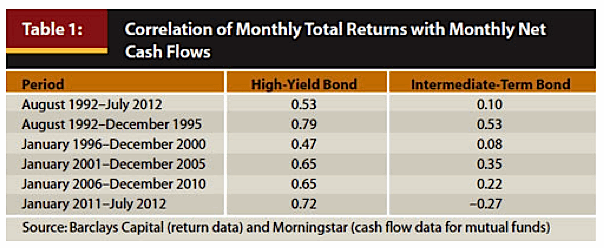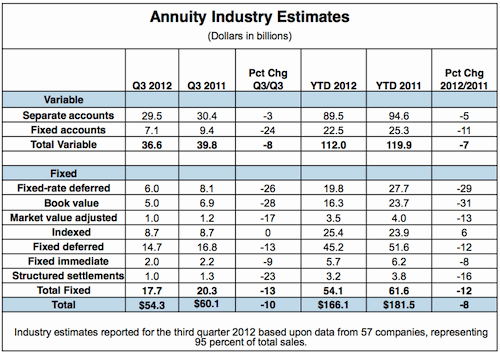Is the variable annuity industry coming or going? Will life insurers, after taking losses in the financial crisis, retreat into the comfort zone of the law of large numbers? Or have they learned enough about derivatives to stay at the Wall Street gaming tables?
One of the best places to look for straight answers to those questions, I’ve found, is the Equity-Based Insurance Guarantees conference hosted each fall by Toronto options expert K. (Ravi) Ravindran and the Society of Actuaries. The eighth annual EBIG meeting, held this week in Chicago, drew 195 actuaries and quants, up from 110 in 2005.
These perennial meetings help bring insurance company actuaries up to speed on derivatives and give banks and consulting firms a chance to tout their options expertise. Goldman Sachs, Deutsche Bank, Barclays, BNP Paribas and Credit Suisse represented Wall Street. Consultants included Milliman, Tower Watson and Aon Benfield. Actuaries and IT folks from Transamerica and Pacific Life shared front-line war stories.
The experts’ answers to all three questions posed at the top of this story were “Yes.” Some insurers are staying in the game; they’re now hearing that the safest way forward is to put investors in volatility-controlled funds. Many have left the game; they’re learning that the risks buried in their existing blocks of business might still come back to haunt them.
While listening to the presentations—most of whose content, including terms like contango and backwardization, sailed far over my head—a couple of questions nagged at me. First, the design and maintenance of VA products is getting more complex and more expensive; is that a smart idea? Second, could the industry be gearing up to “fight the last war”? In a world ruled by Dodd-Frank and Solvency II, will market volatility be the biggest danger?
At this juncture, life insurers face a greed-fear quandary vis-à-vis VAs. The Fed’s open-ended financial repression policy argues in favor of hunkering down. But the presence of a huge and hungry market for guaranteed income products argues in favor of forging ahead.
Indeed, opportunity continues to knock. “There’s a disconnect in the marketplace,” said Matt Zimmerman, who sells Milliman’s volatility-control hedge program. “VA providers are pulling back, but financial advisors and investors are clamoring for guaranteed income riders. One of the wirehouses, for instance, has massive demand coming on, and they want to add certain insurers to their shelf, but those insurers don’t have the capacity to take on that business.”
How to proceed—safely
Companies that plan to keep selling variable annuities with guaranteed income riders will most likely require contract owners to invest some or all of their premia in volatility-controlled funds. That was a major takeaway from the conference.
“The whole mantra is volatility-controlled funds and managed volatility funds,” said Ravindran in his opening comments on Monday. “It’s been of interest for a few years, but more writers are focusing on that, and you’ll be hearing a lot about that here.”
Those volatility-controlled funds, such as the TOPS funds that are now used by several insurers to manage the risks of variable insurance products, shift risk from the insurer to the investor. In the past, when an insurer hedged a VA, it held the options on its own balance sheet. That design led to losses during the financial crisis. In new “low-vol” funds, the funds themselves—i.e., the contract owners—hold the derivatives.
“It’s a two component approach—volatility management and capital protection,” said Milliman’s Zimmerman, whose firm designed the dynamic hedging strategy in the TOPS funds.
“The volatility component involves buying inverse exchange-traded futures contracts, based on a major index, such as the FTSE, NASDAQ or Nikkei, and targeting about 10% volatility,” Zimmerman said. The capital protection strategy involves buying a five-year rolling equity put for each subaccount, which replicates a five-year rolling maturity put option on the portfolio. (See RIJ’s December 2011 story on “Airbag-Equipped Annuities.”)
“That strategy would be too expensive on its own, but it isn’t as expensive when you couple it with volatility management,” he added. “There’s a little over $1 billion in those funds now, and that will increase with launches next May. We think that employing protected accounts will become the norm for this market.” It remains to be seen, however, whether those low-vol funds are able to capture enough upside to keep advisors and clients happy.
How to stop the bleeding
What about the life insurers that are retreating from VAs? If they have a large legacy block of contracts with generous riders, their worries aren’t over. They still face market risk, longevity risk, and policyholder behavior risk on their guarantees.
Longevity risk is a major wild card, said Tim Paris of Ruark Insurance Advisors. He recommended that companies look into reinsurance for the longevity risk in their legacy blocks. While reinsurers have largely left the VA market, he said, coverage for the longevity risk component is available.
“Variable annuity mortality doesn’t follow the standard mortality tables,” Paris said. “People who elected the death benefit ratchet had 20% higher than average mortality, but people who elected a rich living benefit had 20% lower mortality. Those selection effects were magnified by policy size. A policy of $250,000 or more tended to be the smart money; the smaller policies were not quite as savvy.”
The month-to-month fluctuations in mortality among VA owners can be significant—and ill timed, Paris said. “We looked at monthly mortality as a percentage of Ruark’s [proprietary] mortality tables over 84 months and found them to be as low as 50% of average and as high as 170% of average. We saw similar numbers across eight or nine insurance companies. That’s a lot of volatility.
“What matters even more is the interaction of this pattern with the net amount at risk at any given time,” he added. “If you hit 50% of expected mortality when the excess benefit was $1 billion, you’d make money. But if you hit 170% when the amount at risk was $1 billion, you’d have lost even more.”
Policyholder behavior is even less predictable than mortality rates. So far, no clear pattern has emerged in the utilization rate of the income guarantees. “Over the next couple of years, we’ll see a lot of GMIBs (guaranteed minimum income benefits) reaching the end of the accumulation period,” Paris said. “We’ll learn a lot about policyholder behavior then.”
Addressing another legacy block issue, executives from Transamerica—which has offered to buy back in-the-money riders from contract owners as a way of trimming excess risk from its VA block—described the difficulty of building and maintaining a system that can accurately assess the risks in a large block of VA contracts with living benefit riders.
“A barebones variable annuity is a complicated set of derivatives. Just to price one policy you’re talking about hundreds of variables,” said an IT executive at Transamerica, which has about 700,000 VA policies worth $55 billion. “As I dug into the products, I was shocked at the various forms of risk.”
Aside from modeling risks, those systems also have to generate reports that senior executives can readily interpret and act on. That’s a significant task in itself. “Having information systems that funnel information upward and consolidate data in a decision-friendly way is increasingly important, because C-suite managers are more involved [in the VA business segment] at this point,” said Cornelia Spiegel of Deutsche Bank.
‘The only game in town’
“Should we de-risk or focus on growth? That’s the big question,” said Spiegel, in an overview of the cross-currents in the VA market. “On the one hand, you have 10,000 boomers turning 65 each day, and a generation of 107 million coming in after them. Seventy percent of their assets are in retirement related products.
“On the other hand, we have capacity constraints,” she added. “The product is still complex. Reserving is expensive. Interest rates are low. What is a comfortable level of sales? It’s a challenging balance. In the long run the industry outlook is positive, especially as we roll out new products, and as long as we can insulate ourselves from the risks in the legacy books.” Asked if optimism about the VA market was truly justified, she said, “No other product gives you principal protection and lifetime income. It’s the only game in town.”
© 2012 RIJ Publishing LLC. All rights reserved.







 The authors don’t appear to favor one paradigm over another, but they imply that as advisors grow in sophistication and experience, they’re likely to graduate from the Traditional to the Life Cycle paradigm and then, depending on their own preference or level of interpersonal skill, to the Behavioral and Advisor Experience paradigms.
The authors don’t appear to favor one paradigm over another, but they imply that as advisors grow in sophistication and experience, they’re likely to graduate from the Traditional to the Life Cycle paradigm and then, depending on their own preference or level of interpersonal skill, to the Behavioral and Advisor Experience paradigms. A retirement income-oriented advisor, almost by definition, has to adopt the Life Cycle paradigm, which emphasizes risk management, goal-setting, and asset-liability matching, as well as a greater awareness of the erosion of purchasing power by inflation over a long retirement.
A retirement income-oriented advisor, almost by definition, has to adopt the Life Cycle paradigm, which emphasizes risk management, goal-setting, and asset-liability matching, as well as a greater awareness of the erosion of purchasing power by inflation over a long retirement.
